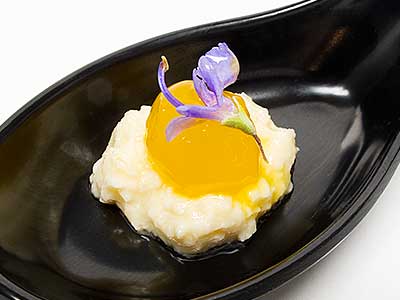November 5, 2012
Amuse-Bouche

œuf dans un nid
(egg in its nest)
This may seem like a skipping record—do people even know what that means any more? This is the fifth time I’m writing about using miso to pickle some food item. The original idea of doing misozuke came from a series of postings in April, 2011, on Playing with Fire and Water. Eggs should have been the first item I wrote about, but that turned out not to be.
The first posting I read called for cooking quail eggs at a specific temperature in a temperature-controlled water bath. When I tried doing this, I was unsuccessful at consistently extracting useable yolks from the partially cooked eggs. So I put the idea aside while I made misozuke out of every edible thing that wandered into my kitchen. Then one day I was playing with dissolving egg shells in acetic acid. This left me with perfect eggs sans shell. The remaining double membrane under the shell held the white and yolk in place as if the shell was still there, and it seemed quite resistant to handling. So into miso a couple eggs went.
A few weeks later, the eggs looked exactly the same except slightly browner. Had the miso produced no effect? I popped the membrane on one, and a firm yolk fell out of the watery white. Maybe this method did work? The same was true for the second egg. Wahoo!
Now it was time, with a little more determination, to start the whole process from the beginning. On my next trip to the market, I picked up a dozen quail eggs. Seven went into making deviled eggs and five were headed towards a two-week long bath. The five eggs were placed in a non-reactive bowl and covered with 6% acetic acid, a.k.a. plain white distilled vinegar. The bowl was covered tightly with a piece of plastic film and placed in the refrigerator.
After a night in the refrigerator, the patterned, outer layer of the shells was loosely floating in the vinegar as if it were small pieces of plastic film. As I washed each egg under cold, running water, most of the remaining shell washed away. Gentle rubbing with a finger tip was all that was necessary to remove the remainder of the shell. If a shell is stubborn, which happens occasionally, additional time in the vinegar may be required.
With the shells removed, the eggs resemble egg-shaped water balloons. The double membrane encapsulating the white has a somewhat frosty appearance. You think you can see the yolk through the membrane, but you are not sure. Under slight pressure the surface pushes in, like a balloon, but there also is a sense that if you pushed too hard, the membranes would rupture.
To immerse the eggs in miso, I placed a thick layer of the miso in the bottom of a 500 ml (2 c) deli container. I used one of my rather-fat thumbs to make a depression in the miso, and with my other hand, placed an egg in the indentation. This was repeated until all five of the eggs were mired in the miso. More miso was added to totally submerse the eggs. The lid was placed on the container, and its contents and date marked on the top. The container was then set out-of-sight in the back of the refrigerator.
After two weeks, it was time to see the results. (Also, I needed another amuse-bouche for the dinner I was serving that evening.) As before, the eggs didn’t look significantly different than before their miso soaking, just a bit browner. I used the tips of a pair of angled tweezers to make a small tear in the narrow end of each egg. As I did so, I drained the white into a small bowl. The membrane was then further torn, and the gelatinous yolks removed. They were placed in a second, small bowl. After all the eggs were opened, the yolks were washed under cold water to remove any loose material clinging to them. The bowl with the yolks was covered with plastic film and set back into the refrigerator until service.
At this point, the “white” no longer was. It had the appearance of weak, black tea, or maybe a not-too-intense beef broth, and the viscosity was now like that of tea or broth. It no longer resembled normal egg white in any way, shape, or form.
I decided to cook the whites. I tightly covered the bowl they were in with plastic wrap and pieced a very small hole in the top with the tip of a knife. The bowl was set in simmering water whose depth was approximately equal to the depth of the whites so the bowl would almost float in the water. I left the bowl in the simmering water until the whites appeared fully coagulated. I had hoped that they would cook hard like they would have prior to pickling, but instead they formed a grainy custard. This bowl was also refrigerated until it was time to serve.
To present the eggs to my guests, I selected some black, Chinese-style spoons. I used two demitasse spoons to dish out a small mound of the cooked whites onto the center of the bowl of each spoon. Using the angled tweezers held upside-down, I inserted the two tips below each yolk in the bowl and carefully lifted the yolks out of the bowl as if I was using a two-tined fork. Each was placed on one of the mounds of white. One-by-one, I gently pushed the yolks into the whites so they would stay put. To round out the presentation, I placed a rosemary blossom on top of each yolk.
© 2012 Peter Hertzmann. All rights reserved.
